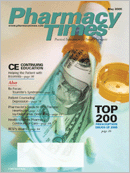Publication
Article
Pharmacy Times
compounding HOTLINE
Author(s):
Q: Can you please supply the stability of salicylic acidointment 20%, with references?
A: Salicylic acid (SA) is available as a white powder orcolorless crystals with a sweet, acrid taste. It is odorless,but irritating to nostrils. It has a melting point of 158ºC to161ºC. Reported solubilities are 1 in 550, water; 1 in 4, ethanol;and 1 in 809, olive or almond oil. It also is soluble in whitepetrolatum (~1 in 80). SA solubility in water is increased by thepresence of borax, ammonium citrate, ammonium acetate,sodium citrate, potassium citrate, and sodium phosphate. SAis incompatible with iodine, iron salts (use a hard rubber spatula),and oxidizing substances.
SA can increase viscosity of solutions containing quaternaryammonium compounds, probably due to increased micelle size.It has been reported that SA was most readily released fromemulsion bases, especially oil-in-water vehicles, and that incorporationof SA in ointment base using cold spatulation yieldedhigher diffusion rates than when fusion technique was used.
SA is bactericidal, fungicidal, and keratolytic. Combined withsulfur, benzoic acid, coal tar, and/or resorcinol, it has beenused in treating eczema, psoriasis, seborrhea, and other skindisorders. It has been used as an exfoliant in treatments forskin aging (wrinkles). It is not chemically a beta-hydroxy acid(BHA), although sometimes it is referred to as such. Investigationsinto effects of ultraviolet light on skin treated withSA and BHA are under way. Applied in concentrations of 10%to 12% in collodion vehicle or in concentrations of 20% to 50%in ointment or "plaster," it will cause sloughing of warts orcorns. The FDA has limited concentrations of SA in OTC productsto 12% to 40% in ointment, 5% to 17% in collodion-likevehicle, and 15% in karaya gum, glycol plaster vehicle(21CFR358.110).
SA/calcipotriene 0.005% ointment preparation stored at5ºC and 25ºC reportedly resulted in incompatibility (calcipotrieneconcentration dropped precipitously). USP29/NF24<795> provides "beyond-use date" (BUD) guidelines, applicablewhen no stability studies for a particular preparation canbe found. These guidelines state: "For nonaqueous liquids andsolid formulations, where a commercially manufactured drugproduct is the source of active ingredient, the BUD is not laterthan 25% of the time remaining until the product's expirationdate or 6 months, whichever is earlier."
Mr. Erickson is director of professional affairs at Gallipot Inc.
E-mail your compounding questions tocompounding@pharmacytimes.com







